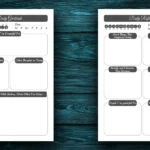Table of Contents
Do you constantly feel like there aren’t enough hours in the day? Are you overwhelmed by endless to-do lists with little to show for your efforts? If you’re nodding in agreement, you’re not alone. In today’s fast-paced world, time management challenges affect nearly everyone—but there’s a powerful solution that can transform your productivity.
Enter the hourly planner—a simple yet powerful tool that divides your day into manageable time blocks, helping you take control of your schedule and maximize every hour. Unlike traditional to-do lists that only tell you what to do, an hourly planner helps you decide when to do it, creating a realistic roadmap for your day.
In this comprehensive guide, we’ll explore everything you need to know about hourly planning—from understanding its core benefits and implementation strategies to accessing free, customizable templates designed for different lifestyles. By the end, you’ll have all the tools and knowledge to reclaim your time and boost your productivity.
What Exactly Is an Hourly Planner? (And Why You Need One)
An hourly planner is a time management tool that divides your day into hour-by-hour (or smaller) time segments, allowing you to assign specific activities to designated time slots. Unlike traditional daily planners that might focus only on appointments or general to-do lists, an hourly planner provides a comprehensive visual breakdown of your entire day.
Key characteristics include:
- Structured time blocks: Typically divided into hourly or half-hourly segments
- Visual timeline format: Lets you see your day at a glance
- Designated spaces: Areas for priorities, notes, and task categorization
- Granular focus: More detailed than daily or weekly planners
- Flexibility: Available in both digital and physical formats
The hour-by-hour planner approach is particularly effective because it addresses the fundamental problem many people face: knowing what needs to be done but struggling to find when to do it. By assigning specific tasks to dedicated time slots, you eliminate the constant decision fatigue of figuring out what to work on next.
The Top 5 Benefits of Using an Hourly Planner:
Benefit 1: Gain Crystal Clear Clarity on Your Time
An hourly planner forces you to confront the reality of your 24 hours. Many of us overestimate what we can accomplish in a day because we don’t visualize how our tasks actually fit into our available time. When you map out your day hour by hour, you immediately see if you’re trying to squeeze 30 hours of work into a 24-hour day.
This clarity helps you:
- Identify exactly where your time goes
- Recognize overcommitment before it happens
- Make more realistic commitments to yourself and others
- Visualize the balance (or imbalance) between different life areas
Time expert Laura Vanderkam notes that people who track their time in detailed increments often discover they have more free time than they thought—it’s just scattered throughout the day in ways that make it difficult to utilize effectively.
Benefit 2: Boost Productivity with Time Blocking
Time blocking—the practice of dedicating specific chunks of time to specific tasks—is a proven productivity technique used by successful people, from Elon Musk to Cal Newport. Your hourly planner template becomes the perfect vessel for implementing this strategy.
Research shows that time blocking works because:
- It leverages Parkinson’s Law (work expands to fill the time allocated)
- It reduces context switching, which can cost up to 40% of productive time
- It creates a psychological commitment to focus during designated periods
- It helps combat procrastination through deadline effects
By creating dedicated blocks for deep work, meetings, administrative tasks, and personal time, you create clear boundaries that protect your most valuable activities from interruptions and distractions.
Benefit 3: Reduce Overwhelm and Procrastination
That feeling of having “too much to do” often stems from the ambiguity of when you’ll actually do each task. An hourly planner transforms vague intentions into concrete plans.
Psychologically, this reduces overwhelm by:
- Breaking large projects into time-bound segments
- Eliminating the paralysis of deciding what to work on next
- Creating the satisfaction of crossing off completed time blocks
- Making progress visible and measurable
Many users report that hourly planning dramatically reduces their procrastination because each task has a designated “appointment” with them. This mental shift from “I should do this sometime” to “I will do this at 2 PM” creates accountability and momentum.
Benefit 4: Improving Time Estimation Skills
One of the most valuable long-term benefits of using an hourly planner is developing more accurate time estimation skills. Most people consistently underestimate how long tasks will take—a phenomenon psychologists call the “planning fallacy.”
As you use your hourly planner consistently, you’ll:
- Learn how long different types of tasks actually take
- Notice patterns in your energy and focus throughout the day
- Develop more realistic expectations for daily output
- Improve your ability to meet deadlines and commitments
This improved time awareness becomes a powerful professional and personal skill that compounds over time, making you more reliable and less stressed about deadlines.
Benefit 5: Achieve Better Work-Life Balance
With the rise of remote work and digital connectivity, the boundaries between work and personal life have become increasingly blurred. An hourly planner helps you intentionally carve out time for all life domains.
By scheduling not just work tasks but also:
- Personal care activities (exercise, meditation, proper meals)
- Family and relationship time
- Hobbies and recreational activities
- Rest and transition periods
You ensure that important non-work activities don’t get sacrificed to never-ending professional demands. This intentional allocation helps prevent burnout and supports overall wellbeing.
Download Your Free Daily Planner Printable

Ready to transform your productivity with hourly planning? We’ve created a collection of high-quality, beautifully designed 2025-2026 hourly planner templates to help you get started immediately.
Our free hourly planner templates include:
- 24-Hourly Planner: Perfect for detailed daily time blocking
- Weekly Overview with Hourly Breakdown: Balance big-picture planning with hourly detail
- Digital-Friendly Templates: Optimized for digital note-taking apps
[Download Your Free Hourly Planner Here]
All templates feature:
- Clean, distraction-free design
- Time slots of 24 hours
- Priority task sections
- Water and habit tracking options
- Notes space for reflection
- Professional, print-ready formatting
Simply download, print, and start planning your most productive day yet!
How to Use Your Hourly Planner Effectively (Step-by-Step)
Having the right hourly planner template is just the beginning. Here’s how to maximize its effectiveness:
Step 1: Choose Your Format (Digital vs. Print)
Both digital and physical hourly planners have distinct advantages:
Digital advantages:
- Easy editing and adjustments
- Syncing across devices
- Integration with calendar apps
- Search functionality
- No physical storage needed
Physical advantages:
- No screen fatigue
- Better memory encoding through handwriting
- No battery or connectivity requirements
- Less distraction potential
- Tactile satisfaction
For digital planning, we recommend apps like Notion, Todoist, or Google Calendar. For physical planning, consider a quality notebook like the Day Designer Daily Planner or Clever Fox Planner Hourly, which offer premium hourly planning layouts with additional goal-setting features.
Step 2: Schedule Fixed Appointments First
Begin your planning by adding all fixed commitments—meetings, classes, appointments, and non-negotiable events. These create the framework around which you’ll plan the rest of your day.
Pro tip: Also include necessary transition and travel time between activities. Many people forget to account for the 15-30 minutes needed to commute or prepare for the next activity.
Step 3: Block Time for Your Top Priorities (MITs)
Identify your Most Important Tasks (MITs)—the 2-3 activities that would make the day successful even if nothing else gets done. Schedule these during your peak energy hours:
- Are you a morning person? Block your most challenging work from 8-11 AM
- Afternoon peak? Reserve 1-4 PM for deep work
- Evening owl? Consider 7-10 PM for creative tasks
The key is to protect your prime hours for priority work rather than reactive tasks like email or meetings when possible.
Step 4: Include Buffer Time & Breaks
One of the biggest planning mistakes is scheduling every minute without margins. Create buffer time by:
- Adding 5-10 minutes between meetings
- Scheduling a 30-minute “catch-up” block mid-day
- Leaving at least one hour unscheduled for unexpected issues
Research consistently shows that short breaks improve overall productivity. Consider implementing techniques like:
- The Pomodoro Method: 25 minutes of focus followed by a 5-minute break
- The 52/17 Rule: 52 minutes of work followed by a 17-minute break
- 90-minute work blocks aligned with natural attention cycles
Step 5: Review and Adjust Daily/Weekly
Your hourly planner isn’t set in stone. The most effective planners set aside time for:
- Morning review (5 minutes): Confirm the day’s plan
- Evening review (10 minutes): Evaluate what worked and what didn’t
- Weekly review (30 minutes): Adjust patterns based on the week’s learnings
This reflective practice transforms your planner from a simple scheduling tool into a system for continuous productivity improvement.
Bonus Tip: Color-Coding Your Tasks
Color-coding adds a visual dimension to your hourly planner that helps you quickly identify:
- Work vs. personal activities
- Energy-draining vs. energizing tasks
- Different projects or clients
- Urgent vs. important activities
Keep your color system simple with 4-5 categories maximum. For analog planners, consider the Zebra Mildliner Highlighters, which offer subtle colors that won’t bleed through paper.
Bonus Tip: Integrating with the Pomodoro Technique
The Pomodoro Technique—working in focused 25-minute intervals followed by 5-minute breaks—pairs perfectly with hourly planning. In your hourly planner, you can:
- Estimate tasks in terms of “pomodoros” (25-minute sessions)
- Mark scheduled break periods between intense focus sessions
- Track completed pomodoros to improve future time estimates
The Focus Keeper Pro app ($4.99) is an excellent digital Pomodoro timer that can complement your hourly planning system.
Hourly Planners for Different Needs (Who Benefits Most?)
While hourly planning works for nearly everyone, different life circumstances require specialized approaches:
For Students: Balancing Classes, Study, & Life
Students juggle fixed class schedules with variable study needs and social activities. An ideal hourly planner for students should:
- Map class schedules and study blocks
- Allow for assignment tracking and deadlines
- Include blocks for extracurricular activities
- Provide space for exam preparation timelines
The Academic Planner Pro offers specialized hourly layouts for students with assignment tracking and exam countdown features.
For Professionals: Managing Meetings & Deep Work
For busy professionals, the challenge is protecting focused work time amid meeting-heavy days:
- Block “meeting days” vs. “focus days” when possible
- Schedule admin tasks (email, Slack) at specific times
- Create boundaries around work hours
- Allocate time for strategic thinking and planning
Digital tools like Calendar or Reclaim.ai ($8/month) can automatically create balanced schedules that protect deep work time between meeting commitments.
For Freelancers: Structuring Client Work & Admin
Freelancers face unique challenges with variable workloads and self-management:
- Allocate specific hours to different clients
- Schedule business development during prime energy hours
- Block administrative time for invoicing and taxes
- Create boundaries between work and personal time
The Freelancer’s Hourly Planner features specialized sections for client billing, project tracking, and marketing activities.
For Busy Parents: Juggling Family, Work, & Self-Care
Parents need hourly planners that accommodate family needs alongside personal and professional responsibilities:
- Coordinate around school schedules and activities
- Block family dinner and quality time
- Plan efficient household management
- Protect small windows for self-care
The Simplified Planner offers family-oriented hourly layouts with meal planning and family activity coordination features.
Hourly Planner vs. Other Planning Methods (Quick Comparison)
How does hourly planning compare to other popular time management approaches?
| Planning Method | Best For | Limitations | Time Horizon |
| Hourly Planner | Detailed daily execution, time blocking | Can feel rigid, requires regular updating | Day to week |
| Daily To-Do Lists | Simple task management, flexibility | No time context, easy to overcommit | Single day |
| Weekly Planners | Big-picture balancing, forward planning | Less detailed, may miss daily priorities | Week |
| Digital Calendar | Meeting management, sharing availability | Often cluttered, poor task integration | Variable |
The hourly planner’s strength lies in its granularity and time awareness. While to-do lists tell you what to do, hourly planners tell you exactly when to do it, creating realistic expectations and better time utilization.
Many productivity experts recommend combining approaches—using weekly planning for big-picture balance, hourly planning for daily execution, and digital calendars for shared commitments and reminders.
Frequently Asked Questions (FAQ) about Hourly Planners
Q1: What’s the difference between an hourly planner and an appointment book?
Answer: While both track time commitments, an hourly planner is more comprehensive. Appointment books focus primarily on scheduled meetings and events, while hourly planners help you intentionally allocate all available time, including work blocks, breaks, and personal activities. Hourly planners typically include additional productivity features like priority sections, habit tracking, and reflection spaces.
Q2: Can I use an hourly planner for habit tracking?
Answer: Absolutely! Hourly planners excel at habit integration by giving habits a specific time slot in your day. This transforms vague intentions (“I’ll exercise sometime”) into concrete plans (“I’ll walk from 12:15-12:45 PM”). Many hourly planner templates include dedicated habit-tracking sections or checkboxes. For maximum effectiveness, try scheduling new habits immediately before or after existing routines to create natural triggers.
Q3: Are digital or paper hourly planners better?
Answer: This depends entirely on your personal preferences and working style. Digital hourly planners offer flexibility, syncing capabilities, and easy editing. Paper planners provide a screen-free planning experience and may improve memory through physical writing. Many productivity experts actually use both: digital for collaborative scheduling and reminders, and paper for daily execution and focus. If you’re unsure, start with our free downloadable templates to experiment before investing in premium options.
Q4: How detailed should my hourly plan be?
Answer: The optimal level of detail depends on your personality and schedule type. Some guidelines:
- For structured roles (teachers, healthcare workers): Plan in 30-minute or hourly increments
- For variable roles (creative professionals, entrepreneurs): Consider 1-2 hour blocks with flexibility
- For beginners: Start with 3-4 big blocks per day rather than planning every minute
- For advanced planners: 30-minute increments offer precision without micromanagement
The goal is sufficient structure to guide your day without creating rigidity that sets you up for frustration. Most productivity experts recommend leaving at least 20% of your day unscheduled to accommodate for unexpected events.
Take Control of Your Time Today
The difference between feeling constantly overwhelmed and confidently productive often comes down to one simple factor: intentional time management. An hourly planner isn’t just another productivity tool—it’s a complete system for transforming how you experience each day.
By implementing the strategies we’ve discussed—from time blocking your priorities to creating appropriate buffers—you can finally escape the cycle of reactivity and take control of your schedule. Whether you’re a student juggling classes, a professional balancing meetings with focused work, or a parent coordinating family needs, an hourly planning approach can transform your relationship with time.
We’ve provided comprehensive templates and clear guidance to help you get started immediately. Download our free hourly planner templates, choose the format that works best for your lifestyle, and begin experiencing the clarity and confidence that comes from knowing exactly how your day will unfold.
What’s your biggest time management challenge? Have you tried hourly planning before? Share your experiences in the comments below—we’d love to hear your story and provide personalized recommendations!
Need help with custom planner design or implementation strategies? Contact our team anytime at [email protected], and we’ll be happy to assist you in creating the perfect planning system for your unique needs.











